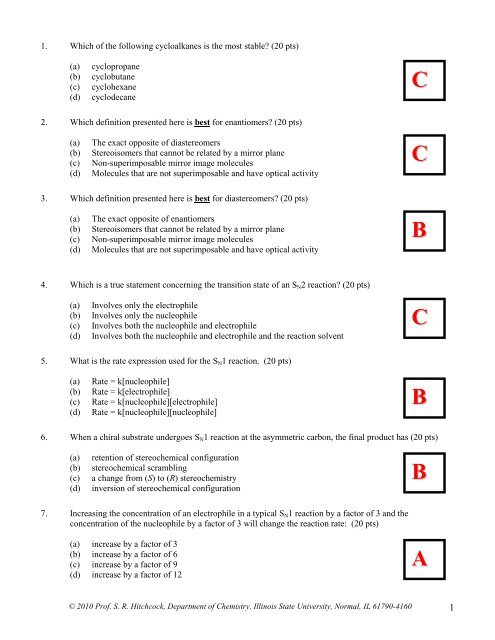2010 che 230 exam 3 solutions - Department of Chemistry - Illinois ...
2010 che 230 exam 3 solutions - Department of Chemistry - Illinois ...
2010 che 230 exam 3 solutions - Department of Chemistry - Illinois ...
You also want an ePaper? Increase the reach of your titles
YUMPU automatically turns print PDFs into web optimized ePapers that Google loves.
1. Which <strong>of</strong> the following cycloalkanes is the most stable (20 pts)<br />
(a)<br />
(b)<br />
(c)<br />
(d)<br />
cyclopropane<br />
cyclobutane<br />
cyclohexane<br />
cyclodecane<br />
C<br />
2. Which definition presented here is best for enantiomers (20 pts)<br />
(a)<br />
(b)<br />
(c)<br />
(d)<br />
The exact opposite <strong>of</strong> diastereomers<br />
Stereoisomers that cannot be related by a mirror plane<br />
Non-superimposable mirror image molecules<br />
Molecules that are not superimposable and have optical activity<br />
C<br />
3. Which definition presented here is best for diastereomers (20 pts)<br />
(a)<br />
(b)<br />
(c)<br />
(d)<br />
The exact opposite <strong>of</strong> enantiomers<br />
Stereoisomers that cannot be related by a mirror plane<br />
Non-superimposable mirror image molecules<br />
Molecules that are not superimposable and have optical activity<br />
B<br />
4. Which is a true statement concerning the transition state <strong>of</strong> an S N 2 reaction (20 pts)<br />
(a)<br />
(b)<br />
(c)<br />
(d)<br />
Involves only the electrophile<br />
Involves only the nucleophile<br />
Involves both the nucleophile and electrophile<br />
Involves both the nucleophile and electrophile and the reaction solvent<br />
C<br />
5. What is the rate expression used for the S N 1 reaction. (20 pts)<br />
(a)<br />
(b)<br />
(c)<br />
(d)<br />
Rate = k[nucleophile]<br />
Rate = k[electrophile]<br />
Rate = k[nucleophile][electrophile]<br />
Rate = k[nucleophile][nucleophile]<br />
B<br />
6. When a chiral substrate undergoes S N 1 reaction at the asymmetric carbon, the final product has (20 pts)<br />
(a)<br />
(b)<br />
(c)<br />
(d)<br />
retention <strong>of</strong> stereo<strong>che</strong>mical configuration<br />
stereo<strong>che</strong>mical scrambling<br />
a change from (S) to (R) stereo<strong>che</strong>mistry<br />
inversion <strong>of</strong> stereo<strong>che</strong>mical configuration<br />
B<br />
7. Increasing the concentration <strong>of</strong> an electrophile in a typical S N 1 reaction by a factor <strong>of</strong> 3 and the<br />
concentration <strong>of</strong> the nucleophile by a factor <strong>of</strong> 3 will change the reaction rate: (20 pts)<br />
(a) increase by a factor <strong>of</strong> 3<br />
(b) increase by a factor <strong>of</strong> 6<br />
(c) increase by a factor <strong>of</strong> 9<br />
(d) increase by a factor <strong>of</strong> 12<br />
A<br />
© <strong>2010</strong> Pr<strong>of</strong>. S. R. Hitchcock, <strong>Department</strong> <strong>of</strong> <strong>Chemistry</strong>, <strong>Illinois</strong> State University, Normal, IL 61790-4160 1

















